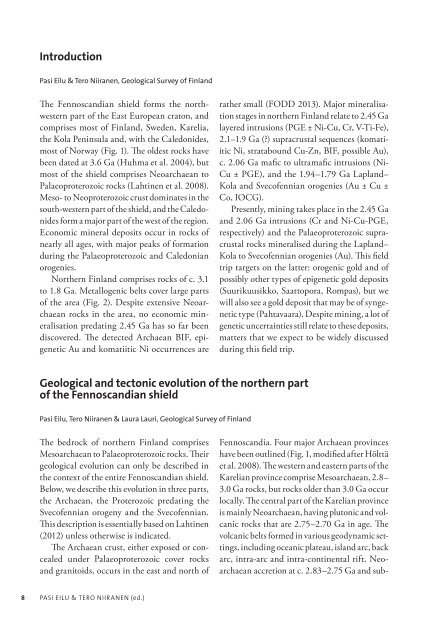Gold deposits in northern Finland - Arkisto.gsf.fi
Gold deposits in northern Finland - Arkisto.gsf.fi
Gold deposits in northern Finland - Arkisto.gsf.fi
Create successful ePaper yourself
Turn your PDF publications into a flip-book with our unique Google optimized e-Paper software.
Introduction<br />
Pasi Eilu & Tero Niiranen, Geological Survey of F<strong>in</strong>land<br />
The Fennoscandian shield forms the northwestern<br />
part of the East European craton, and<br />
comprises most of F<strong>in</strong>land, Sweden, Karelia,<br />
the Kola Pen<strong>in</strong>sula and, with the Caledonides,<br />
most of Norway (Fig. 1). The oldest rocks have<br />
been dated at 3.6 Ga (Huhma et al. 2004), but<br />
most of the shield comprises Neoarchaean to<br />
Palaeoproterozoic rocks (Laht<strong>in</strong>en et al. 2008).<br />
Meso- to Neoproterozoic crust dom<strong>in</strong>ates <strong>in</strong> the<br />
south-western part of the shield, and the Caledonides<br />
form a major part of the west of the region.<br />
Economic m<strong>in</strong>eral <strong>deposits</strong> occur <strong>in</strong> rocks of<br />
nearly all ages, with major peaks of formation<br />
dur<strong>in</strong>g the Palaeoproterozoic and Caledonian<br />
orogenies.<br />
Northern F<strong>in</strong>land comprises rocks of c. 3.1<br />
to 1.8 Ga. Metallogenic belts cover large parts<br />
of the area (Fig. 2). Despite extensive Neoarchaean<br />
rocks <strong>in</strong> the area, no economic m<strong>in</strong>eralisation<br />
predat<strong>in</strong>g 2.45 Ga has so far been<br />
discovered. The detected Archaean BIF, epigenetic<br />
Au and komatiitic Ni occurrences are<br />
rather small (FODD 2013). Major m<strong>in</strong>eralisation<br />
stages <strong>in</strong> <strong>northern</strong> F<strong>in</strong>land relate to 2.45 Ga<br />
layered <strong>in</strong>trusions (PGE ± Ni-Cu, Cr, V-Ti-Fe),<br />
2.1–1.9 Ga (?) supracrustal sequences (komatiitic<br />
Ni, stratabound Cu-Zn, BIF, possible Au),<br />
c. 2.06 Ga ma<strong>fi</strong>c to ultrama<strong>fi</strong>c <strong>in</strong>trusions (Ni-<br />
Cu ± PGE), and the 1.94–1.79 Ga Lapland–<br />
Kola and Svecofennian orogenies (Au ± Cu ±<br />
Co, IOCG).<br />
Presently, m<strong>in</strong><strong>in</strong>g takes place <strong>in</strong> the 2.45 Ga<br />
and 2.06 Ga <strong>in</strong>trusions (Cr and Ni-Cu-PGE,<br />
respectively) and the Palaeoproterozoic supracrustal<br />
rocks m<strong>in</strong>eralised dur<strong>in</strong>g the Lapland–<br />
Kola to Svecofennian orogenies (Au). This <strong>fi</strong>eld<br />
trip targets on the latter: orogenic gold and of<br />
possibly other types of epigenetic gold <strong>deposits</strong><br />
(Suurikuusikko, Saattopora, Rompas), but we<br />
will also see a gold deposit that may be of syngenetic<br />
type (Pahtavaara). Despite m<strong>in</strong><strong>in</strong>g, a lot of<br />
genetic uncerta<strong>in</strong>ties still relate to these <strong>deposits</strong>,<br />
matters that we expect to be widely discussed<br />
dur<strong>in</strong>g this <strong>fi</strong>eld trip.<br />
Geological and tectonic evolution of the <strong>northern</strong> part<br />
of the Fennoscandian shield<br />
Pasi Eilu, Tero Niiranen & Laura Lauri, Geological Survey of F<strong>in</strong>land<br />
The bedrock of <strong>northern</strong> F<strong>in</strong>land comprises<br />
Mesoarchaean to Palaeoproterozoic rocks. Their<br />
geological evolution can only be described <strong>in</strong><br />
the context of the entire Fennoscandian shield.<br />
Below, we describe this evolution <strong>in</strong> three parts,<br />
the Archaean, the Proterozoic predat<strong>in</strong>g the<br />
Svecofennian orogeny and the Svecofennian.<br />
This description is essentially based on Laht<strong>in</strong>en<br />
(2012) unless otherwise is <strong>in</strong>dicated.<br />
The Archaean crust, either exposed or concealed<br />
under Palaeoproterozoic cover rocks<br />
and granitoids, occurs <strong>in</strong> the east and north of<br />
Fenno scandia. Four major Archaean prov<strong>in</strong>ces<br />
have been outl<strong>in</strong>ed (Fig. 1, modi<strong>fi</strong>ed after Hölttä<br />
et al. 2008). The western and eastern parts of the<br />
Karelian prov<strong>in</strong>ce comprise Mesoarchaean, 2.8–<br />
3.0 Ga rocks, but rocks older than 3.0 Ga occur<br />
locally. The central part of the Karelian prov<strong>in</strong>ce<br />
is ma<strong>in</strong>ly Neoarchaean, hav<strong>in</strong>g plutonic and volcanic<br />
rocks that are 2.75–2.70 Ga <strong>in</strong> age. The<br />
volcanic belts formed <strong>in</strong> various geo dynamic sett<strong>in</strong>gs,<br />
<strong>in</strong>clud<strong>in</strong>g oceanic plateau, island arc, back<br />
arc, <strong>in</strong>tra-arc and <strong>in</strong>tra-cont<strong>in</strong>ental rift. Neoarchaean<br />
accretion at c. 2.83–2.75 Ga and sub<br />
8 Pasi Eilu & Tero Niiranen (ed.)
















